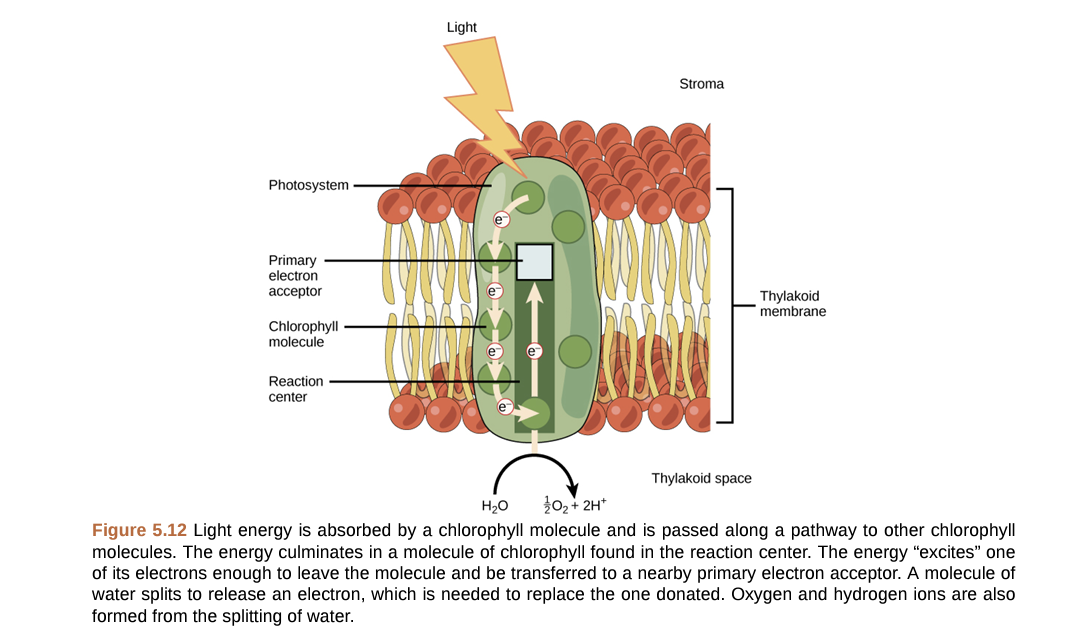Photosystem Primary electron acceptor Chlorophyll molecule Reaction center Light Stroma Thylakoid space Thylakoid membrane H₂O 0₂ + 2H+ Figure 5.12 Light energy is absorbed by a chlorophyll molecule and is passed along a pathway to other chlorophyll molecules. The energy culminates in a molecule of chlorophyll found in the reaction center. The energy "excites" one of its electrons enough to leave the molecule and be transferred to a nearby primary electron acceptor. A molecule of water splits to release an electron, which is needed to replace the one donated. Oxygen and hydrogen ions are also formed from the splitting of water.
Photosystem Primary electron acceptor Chlorophyll molecule Reaction center Light Stroma Thylakoid space Thylakoid membrane H₂O 0₂ + 2H+ Figure 5.12 Light energy is absorbed by a chlorophyll molecule and is passed along a pathway to other chlorophyll molecules. The energy culminates in a molecule of chlorophyll found in the reaction center. The energy "excites" one of its electrons enough to leave the molecule and be transferred to a nearby primary electron acceptor. A molecule of water splits to release an electron, which is needed to replace the one donated. Oxygen and hydrogen ions are also formed from the splitting of water.
Biochemistry
6th Edition
ISBN:9781305577206
Author:Reginald H. Garrett, Charles M. Grisham
Publisher:Reginald H. Garrett, Charles M. Grisham
Chapter21: Photosynthesis
Section: Chapter Questions
Problem 18P: The Overall Free Energy Change for Photosynthetic NADP+ Reduction What is the overall free energy...
Related questions
Question
What do you think is its main purpose of this picture?

Transcribed Image Text:Photosystem
Primary
electron
acceptor
Chlorophyll
molecule
Reaction
center
Light
Stroma
Thylakoid space
Thylakoid
membrane
H₂O
0₂ + 2H+
Figure 5.12 Light energy is absorbed by a chlorophyll molecule and is passed along a pathway to other chlorophyll
molecules. The energy culminates in a molecule of chlorophyll found in the reaction center. The energy "excites" one
of its electrons enough to leave the molecule and be transferred to a nearby primary electron acceptor. A molecule of
water splits to release an electron, which is needed to replace the one donated. Oxygen and hydrogen ions are also
formed from the splitting of water.
Expert Solution
Step 1
INTRODUCTION:-
photosynthesis is defined as the formation of carbohydrates from CO2 and H2O by illuminated green cells of plants, O2 and H2O being the by products...
It is also defined as the capture of photons of light by green plant cells and conversation of their radiant energy into chemical form of energy...
Trending now
This is a popular solution!
Step by step
Solved in 2 steps

Knowledge Booster
Learn more about
Need a deep-dive on the concept behind this application? Look no further. Learn more about this topic, biology and related others by exploring similar questions and additional content below.Recommended textbooks for you

Biochemistry
Biochemistry
ISBN:
9781305577206
Author:
Reginald H. Garrett, Charles M. Grisham
Publisher:
Cengage Learning

Biochemistry
Biochemistry
ISBN:
9781305577206
Author:
Reginald H. Garrett, Charles M. Grisham
Publisher:
Cengage Learning